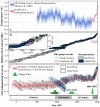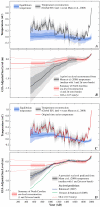Climate related sea-level variations over the past two millennia
- PMID: 21690367
- PMCID: PMC3131350
- DOI: 10.1073/pnas.1015619108
Climate related sea-level variations over the past two millennia
Abstract
We present new sea-level reconstructions for the past 2100 y based on salt-marsh sedimentary sequences from the US Atlantic coast. The data from North Carolina reveal four phases of persistent sea-level change after correction for glacial isostatic adjustment. Sea level was stable from at least BC 100 until AD 950. Sea level then increased for 400 y at a rate of 0.6 mm/y, followed by a further period of stable, or slightly falling, sea level that persisted until the late 19th century. Since then, sea level has risen at an average rate of 2.1 mm/y, representing the steepest century-scale increase of the past two millennia. This rate was initiated between AD 1865 and 1892. Using an extended semiempirical modeling approach, we show that these sea-level changes are consistent with global temperature for at least the past millennium.
Conflict of interest statement
The authors declare no conflict of interest.
Figures

 ). RSL was estimated by subtracting PME from measured sample altitude.
). RSL was estimated by subtracting PME from measured sample altitude.




Comment in
-
Comment on the subsidence adjustment applied to the Kemp et al. proxy of North Carolina relative sea level.Proc Natl Acad Sci U S A. 2011 Oct 4;108(40):E781-2; author reply E783. doi: 10.1073/pnas.1111523108. Epub 2011 Sep 29. Proc Natl Acad Sci U S A. 2011. PMID: 21960439 Free PMC article. No abstract available.
References
-
- Jansen E, et al. Paleoclimate. In: Solomon S, et al., editors. Climate Change 2007: The Physical Science Basis. Contributionof Working Group I to the Fourth Assessment Report of the Intergovernmental Panel on Climate Change. New York City: Cambridge University Press; 2007.
-
- Rahmstorf S. A semi-empirical approach to projecting future sea-level rise. Science. 2007;315:368–370. - PubMed
-
- Horton B, Edwards R. Quantifying Holocene sea-level change using intertidal foraminifera: lessons from the British Isles. Fredericksburg, VA: Cushman Foundation for Foraminiferal Research; 2006. p. 97.
LinkOut - more resources
Full Text Sources
Miscellaneous

